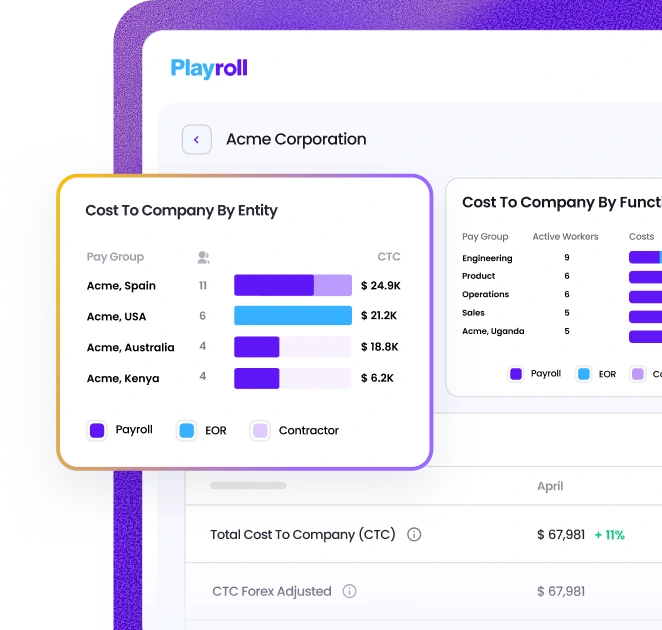Overview of Payroll Taxes in Italy
Understanding payroll taxes in Italy is crucial for ensuring compliance with local regulations. Employers must manage several taxes, including income tax withholding (IRPEF), social security contributions, and regional and municipal surcharges. Non-compliance with these regulations can lead to penalties and strained employee relations. This guide provides an overview of the key aspects of payroll taxes in Italy, including calculation methods, submission processes, and compliance deadlines.
Fiscal Year in Italy
1 January - 31 December is the 12-month accounting period that businesses in Italy use for financial and tax reporting purposes.
Payroll Cycle in Italy
The payroll cycle in Italy is usually monthly, with employees being paid on the 27th of each month.
Bonus Payments in Italy
In Italy, the 13th-month pay, referred to as the "tredicesima," is provided annually alongside the December salary. Additionally, certain National Collective Agreements (NCAs) may include a 14th-month instalment, typically given in June.
Types of Payroll Taxes in Italy
In Italy, employers are responsible for several types of payroll taxes, each with specific regulations and compliance requirements. These include:
Income Tax Withholding (IRPEF)
Employers must withhold personal income tax (IRPEF) from employees' salaries. Italy employs a progressive tax system, with rates ranging from 23% to 43% depending on income levels. Employers are required to calculate and remit these taxes to the Italian Revenue Agency (Agenzia delle Entrate) monthly. Non-compliance can result in significant penalties.
Social Security Contributions (INPS)
Both employers and employees contribute to the National Institute of Social Security (INPS). Employer contributions typically range from 27% to 32% of the employee's gross salary, while employees contribute approximately 9% to 10%. These contributions fund pensions, unemployment benefits, and other social services. Contributions must be reported and paid monthly or quarterly.
Regional and Municipal Taxes
Employees are also subject to regional and municipal surcharges. Regional taxes range from 1.2% to 3.33%, while municipal taxes vary between 0.1% and 0.9%. Employers are responsible for withholding these taxes and remitting them to local authorities.
How To Set Up Payroll in Italy
Setting up payroll in Italy requires compliance with legal and administrative processes. Employers must register with the Agenzia delle Entrate (Tax Office), INPS (Social Security), and INAIL (Insurance Institute). Additionally, they must submit necessary documents to the Register of Enterprises and open a local bank account. Consulting local experts is recommended to navigate these complexities.
Example Calculation
Consider an employee with an annual gross salary of €60,000. The income tax (IRPEF) is calculated progressively:
- 23% on the first €15,000
- 25% on the next €13,000
- 35% on the next €22,000
- 43% on the remaining €10,000
This results in an approximate income tax of €16,370. Additionally, social security contributions are deducted, with employers contributing 27% to 32% and employees contributing 9% to 10% of the gross salary.
Submitting Payroll Tax in Italy
Employers can submit payroll taxes in Italy through:
- Online portals, such as the Agenzia delle Entrate and INPS websites.
- Authorized intermediaries, including certified payroll service providers.
- Direct submissions to local offices.
Payroll Tax Due Dates in Italy
Payroll Contributions in Italy
Understanding the tax obligations for both employers and employees is crucial when operating in Italy's business landscape. This section explains how taxes and statutory fees affect payroll and individual earnings in Italy.
Employer Tax Contributions
Employer payroll contributions are generally estimated at an additional 38% on top of the employee salary in Italy.
Employee Payroll Tax Contributions
In Italy , the typical estimation for employee payroll contributions cost is around 10%.
Individual Income Tax Contributions
The individual income tax in Italy is calculated according to progressive rates. Factors such as household status and number of children may influence overall rates.
Pension in Italy
INPS manages Italian pensions, funded by employer and employee contributions through Social Security. To qualify for old-age benefits, individuals need a minimum of 20 years of contributions, must meet the age requirement (67 for both genders), and are about to retire. Early retirement is possible with at least 41 years and 10 months of contributions (42 years and 10 months for men), regardless of age.
Ready for Payroll That Fits Your Workflow?
Make better business decisions by consolidating global payroll data, while seamlessly syncing your existing payroll operations.

- Instantly integrate outsourced and in-house payroll.

- Interactive variance analysis to prevent errors.

- Create custom reports and access in-depth analytics.

Managing Common Payroll Challenges in Italy
Global employers operating in Italy often encounter unique payroll challenges that can affect compliance and efficiency, like navigating evolving tax laws and managing employee data. With a need for real-time accuracy, modern organizations must develop strategies to overcome these challenges effectively. Below, we explore some of the most common payroll hurdles and provide actionable solutions to streamline payroll processes in Italy.
Maintaining Accurate and Detailed Payroll Reports
Maintaining accurate global payroll reports is often challenging due to currency exchange complexities, data integration issues, and the need to keep employee information up-to-date – including tax information, hours worked, leave balances, and any changes in salary or job status. Generating accurate reports is easy with a comprehensive payroll automation tool that consolidates fragmented data sources, and can keep track of employee payments and deductions.
Keeping Up With Ever-Changing Tax Laws & Compliance Laws
In Italy, tax laws and compliance regulations can change frequently, presenting a significant challenge for global employers. Monitoring updates to federal, state, and local tax codes is crucial to avoid non-compliance and costly penalties, but requires significant time and resources. Partnering with local experts or a reputable global HR platform is an effective way to maintain compliance. These services can help employers stay compliant with evolving regulations while freeing up time for more strategic work.
Consolidating Multi-Vendor Payroll Analytics
Managing payroll across multiple vendors often leads to fragmented data and inefficiencies, making it difficult to consolidate analytics. These challenges can hinder decision-making, especially when trying to gain a clear view of workforce costs and trends. To address this, organizations can invest in a centralized payroll management system that unifies data from multiple vendors. A consolidated platform simplifies payroll tracking, ensures data accuracy, and provides actionable insights into payroll expenditures.

Integrating Multiple HR & Payroll Systems
Global companies are prone to using multiple HR or payroll systems across regions, which can easily lead to fragmented payroll data, increasing the risk of delays and errors in employee compensation. To combat this, seamless integration between payroll and other systems is critical.
Payroll management systems that connect with existing HR and financial platforms can help streamline workflows by reducing manual inputs and ensuring that all departments operate with up-to-date, accurate information. In turn, this helps guarantee on-time, accurate payroll, boosting employee satisfaction.
What Does a Global Payroll Management Platform Cover?
A global payroll management platform is a software solution designed to streamline and automate the payroll processes for organizations with employees across multiple countries. It helps ensure accurate and timely payment while maintaining compliance with legal and regulatory requirements in Italy.
Key functions of a payroll management platform can include:
- Consolidate payroll data: Streamline fragmented payroll data into one source of truth when you’re operating in multiple regions.
- Analytics and reporting: Advanced capabilities to analyze payroll data and generate automated reports per region.
- Monitor and standardize payroll: Get an accurate view of employee costs, bonuses, and taxes per region, catch variances, and standardize payroll processes across regions to minimize errors.
- Compliance and record-keeping: Maintains accurate payroll records and ensures adherence to labor laws and regulations, reducing the risk of legal issues.
- Employee self-service: Provides portals where employees can access pay stubs, update personal information, and manage benefits selections.
How Playroll Can Streamline Payroll & Taxes in Italy
Expanding globally is an exciting milestone for any company, but it comes coupled with complex payroll challenges. It doesn’t have to be complicated. At Playroll, our easy-to-implement global payroll management software combines automation with hands-on support to make global payroll truly simple. Here's how Playroll helps:
- Multi-Vendor Integration: Our platform syncs seamlessly with your providers and in-house systems to unify global payroll services in one platform.
- Standardize Payroll Processes: Unify your operations in one dashboard to ensure payroll is running smoothly globally, with advanced approval flows and reports.
- Improve Governance & Compliance: Improve compliance by centralizing all your compliance tasks and processes. Easily track your payment obligations, with digitized audit trails.
- Advanced Reporting: Access and configure your data, your way, with a comprehensive suite of payroll analytics and reporting tools.
Disclaimer
THIS CONTENT IS FOR INFORMATIONAL PURPOSES ONLY AND DOES NOT CONSTITUTE LEGAL OR TAX ADVICE. You should always consult with and rely on your own legal and/or tax advisor(s). Playroll does not provide legal or tax advice. The information is general and not tailored to a specific company or workforce and does not reflect Playroll’s product delivery in any given jurisdiction. Playroll makes no representations or warranties concerning the accuracy, completeness, or timeliness of this information and shall have no liability arising out of or in connection with it, including any loss caused by use of, or reliance on, the information.
.svg)
.svg)
.svg)






.svg)



.png)












.webp)









.svg)